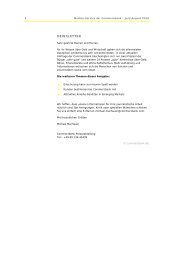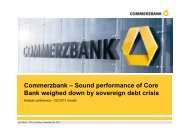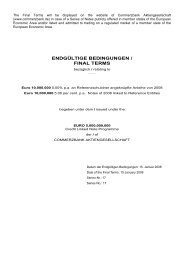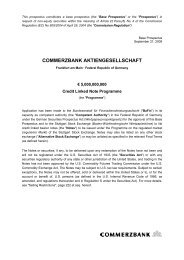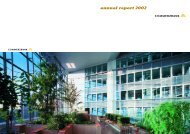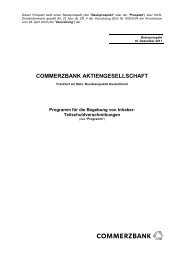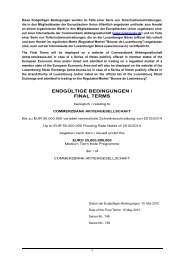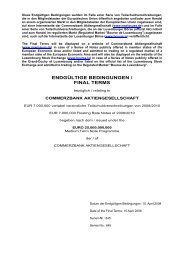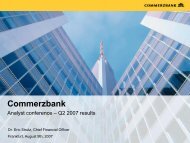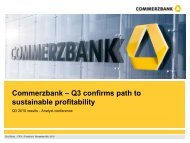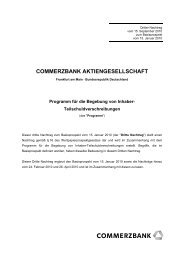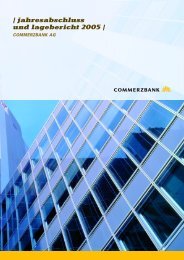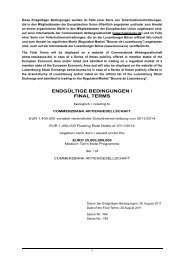COMMERZBANK AKTIENGESELLSCHAFT
COMMERZBANK AKTIENGESELLSCHAFT
COMMERZBANK AKTIENGESELLSCHAFT
Create successful ePaper yourself
Turn your PDF publications into a flip-book with our unique Google optimized e-Paper software.
Group Financial Statements<br />
354<br />
298 Commerzbank Annual Report 2011<br />
(85) Market risk<br />
Market risk is the risk of financial losses due to changes in<br />
market prices (interest rates, commodities, credit spreads,<br />
exchange rates and equity prices) or in parameters that affect<br />
prices such as volatilities and correlations. The losses may<br />
impact profit or loss directly, e.g. in the case of trading book<br />
positions, or they may be reflected in the revaluation reserve or<br />
in hidden liabilities/reserves in the case of banking book<br />
positions. We also monitor market liquidity risk, which covers<br />
cases where it is not possible for the Bank to liquidate or hedge<br />
risky positions in a timely manner and to the desired extent on<br />
acceptable terms as a result of insufficient liquidity in the<br />
market.<br />
Market risk is managed by means of a sophisticated system<br />
of limits, combined with reliable and optimized methods for<br />
measuring and monitoring. Commerzbank uses economic capital<br />
(risk-taking capability) and business expectations to establish its<br />
market risk limits, which ensures a risk/reward-based<br />
management of market risk. The extent to which the limits are<br />
used, together with the relevant P&L figures, is reported daily to<br />
the Board of Managing Directors and the various heads of<br />
divisions.<br />
For the daily quantification and monitoring of market risk,<br />
especially that arising in proprietary trading, statistical methods<br />
are used to calculate the value at risk (VaR). The underlying<br />
statistical parameters for the regulatory capital adequacy<br />
requirements are based on an observation period of the past 254<br />
trading days, a 10-day holding period and a confidence level of<br />
99%. For internal market risk management the same<br />
observation period is used, with a 1-day holding period and a<br />
confidence level of 97.5%. The value at risk models are being<br />
constantly adapted to the changing environment.<br />
As a result of the takeover of Dresdner Bank and with the<br />
agreement of the German Federal Financial Supervisory<br />
Authority (BaFin) Commerzbank temporarily used two parallel<br />
market risk models which had both been approved by the<br />
supervisory authorities to determine its regulatory capital<br />
adequacy requirements in the first three quarters of 2011. For<br />
the positions of the old Commerzbank general market risk was<br />
calculated on the basis of an historical simulation, while specific<br />
interest rate risk (specific market risk) was calculated by means<br />
of a variance/covariance approach. For the positions of the<br />
former Dresdner Bank we used a VaR model based on historical<br />
data with a stochastic Gaussian normal distribution assumption.<br />
At the end of December 2011 the Federal Financial Supervisory<br />
Authority (BaFin) gave Commerzbank the authorisation to use<br />
the newly developed internal VaR model on the basis of an<br />
historical simulation to calculate both general market risk and<br />
specific interest rate risk. Commerzbank has been using this<br />
model since the fourth quarter of 2011 to calculate market risk<br />
and the capital adequacy requirements. The model includes<br />
methods and processes to calculate additional market risk<br />
indicators (Stressed VaR, Equity Event VaR and Incremental Risk<br />
Charge) to meet the Basel 2.5 regulatory requirements as of<br />
December 31, 2011.<br />
Commerzbank is now using the same market risk model<br />
based on an historical simulation for internal risk management<br />
and for calculating regulatory capital. This ensures that risk<br />
measurement is consistent across the whole Group and will meet<br />
the future requirements of Basel III.<br />
The reliability of the internal model in use at any time is<br />
regularly checked using backtesting methods. Apart from<br />
meeting supervisory requirements, the aim is to assess and<br />
steadily improve forecasting quality. The number of significant<br />
deviations is also used by the supervisory authorities as the<br />
basis for the evaluation of the internal risk models.<br />
The table below shows the group-wide regulatory market risk<br />
of the trading portfolio including the foreign exchange risks of<br />
the banking book, as used for calculating capital requirements.<br />
The value at risk shows the potential losses which will not be<br />
exceeded with a 99% degree of probability for a holding period<br />
of 10 days:<br />
Group<br />
€m 31.12.2011 31.12.2010<br />
Minimum 119.3 165.2<br />
Median 210.1 236.1<br />
Maximum 323.2 320.8<br />
Year-end figure 186.9 250.4



